The ASUS X99 Rampage V Extreme ROG Review
by Ian Cutress on June 22, 2015 8:45 AM EST- Posted in
- Motherboards
- Asus
- ROG
- Haswell-E
- X99
CPU Performance
Readers of our motherboard review section will have noted the trend in modern motherboards to implement a form of MultiCore Enhancement / Acceleration / Turbo (read our report here) on their motherboards. This does several things, including better benchmark results at stock settings (not entirely needed if overclocking is an end-user goal) at the expense of heat and temperature. It also gives in essence an automatic overclock which may be against what the user wants. Our testing methodology is ‘out-of-the-box’, with the latest public BIOS installed and XMP enabled, and thus subject to the whims of this feature. It is ultimately up to the motherboard manufacturer to take this risk – and manufacturers taking risks in the setup is something they do on every product (think C-state settings, USB priority, DPC Latency / monitoring priority, memory subtimings at JEDEC). Processor speed change is part of that risk, and ultimately if no overclocking is planned, some motherboards will affect how fast that shiny new processor goes and can be an important factor in the system build.
For reference, the ASUS X99 Rampage V Extreme does implement MultiCore Turbo.
Video Conversion – Handbrake v0.9.9: link
Handbrake is a media conversion tool that was initially designed to help DVD ISOs and Video CDs into more common video formats. The principle today is still the same, primarily as an output for H.264 + AAC/MP3 audio within an MKV container. In our test we use the same videos as in the Xilisoft test, and results are given in frames per second.

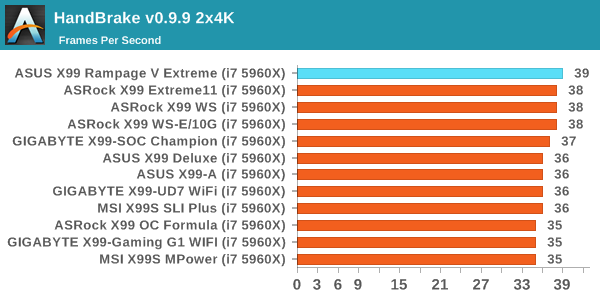
Rendering – PovRay 3.7: link
The Persistence of Vision RayTracer, or PovRay, is a freeware package for as the name suggests, ray tracing. It is a pure renderer, rather than modeling software, but the latest beta version contains a handy benchmark for stressing all processing threads on a platform. We have been using this test in motherboard reviews to test memory stability at various CPU speeds to good effect – if it passes the test, the IMC in the CPU is stable for a given CPU speed. As a CPU test, it runs for approximately 2-3 minutes on high end platforms.

Point Calculations – 3D Movement Algorithm Test: link
3DPM is a self-penned benchmark, taking basic 3D movement algorithms used in Brownian Motion simulations and testing them for speed. High floating point performance, MHz and IPC wins in the single thread version, whereas the multithread version has to handle the threads and loves more cores. For a brief explanation of the platform agnostic coding behind this benchmark, see my forum post here.
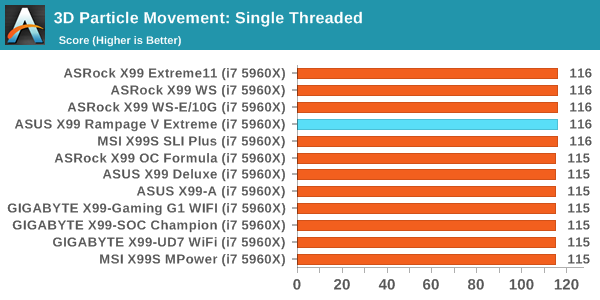

Compression – WinRAR 5.0.1: link
Our WinRAR test from 2013 is updated to the latest version of WinRAR at the start of 2014. We compress a set of 2867 files across 320 folders totaling 1.52 GB in size – 95% of these files are small typical website files, and the rest (90% of the size) are small 30 second 720p videos.
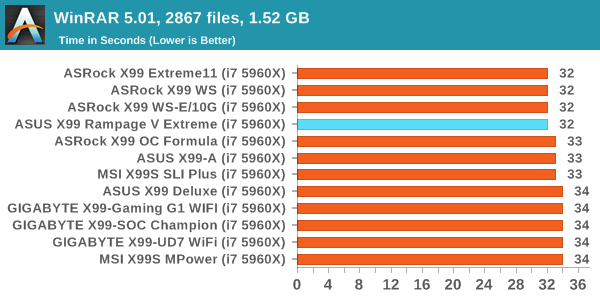
Image Manipulation – FastStone Image Viewer 4.9: link
Similarly to WinRAR, the FastStone test us updated for 2014 to the latest version. FastStone is the program I use to perform quick or bulk actions on images, such as resizing, adjusting for color and cropping. In our test we take a series of 170 images in various sizes and formats and convert them all into 640x480 .gif files, maintaining the aspect ratio. FastStone does not use multithreading for this test, and thus single threaded performance is often the winner.
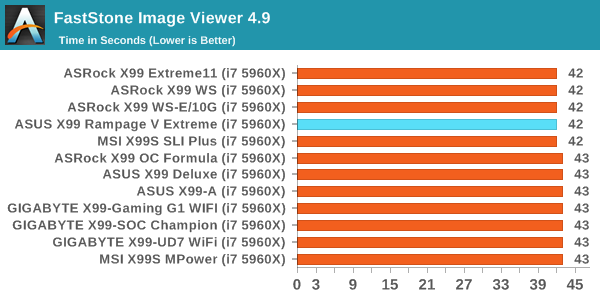
Synthetic – 7-Zip 9.2: link
As an open source compression tool, 7-Zip is a popular tool for making sets of files easier to handle and transfer. The software offers up its own benchmark, to which we report the result.
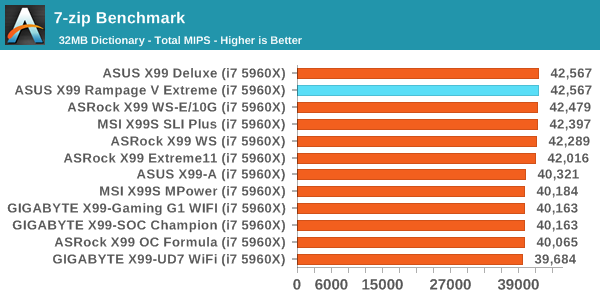










41 Comments
View All Comments
DanNeely - Monday, June 22, 2015 - link
It *IS* a standard though. The common layout you see in 99% of mobos is the one from an ATX spec from many years ago.marraco - Monday, June 22, 2015 - link
What about wifi tests?Most wifi routers reviews never care about different routers performing different with various clients, like USB dongles, integrated wifi, etc.
So, it is very important to know the performance of integrated WIFI, vs USB dongle, versus other solutions.
DanNeely - Monday, June 22, 2015 - link
IIRC where Ian lives is so built up and has so many networks fighting for limited spectrum that all you'd see is a universal faceplant if he tried to do wifi testing.arneberg - Monday, June 22, 2015 - link
Nice motherboard but i miss pci-e lanes, 2 pci-e are to little (in full x16 speed) And there should be 2 M.2 pci-e v3 x4 ports and where is the 8636 ports? otherwise a beutiful card have the x79 version myself. Ihope they come out with a updated board a x99 black maybe? I have used asus mainboards för maybe 20 years now and been wery satisfied with them but for x99 i have a asrock becouse of better features. if i could choice i rather have a asus board.arneberg - Monday, June 22, 2015 - link
Sorry for the bad english in my last post !I hope some motherboard manufacturer have the guts to take away sata express (to slow anyway for the fastest ssd ) and most of the sata ports (we may need them, now but in a few year who need it i use 1 for storing games on a ssd, the system is on a nvme disk (pci-e), and have the new 8639 ports instead. More M.2 pci-e v3 x4 ports and chip to double up the pci-e lines. then i would buy the motherboard.
aron9621 - Monday, June 22, 2015 - link
"With 40 PCIe lane CPUs, the processor supplies x16/x8/x16/- in tri-GPU mode..."The Rampage V can only handle 16x/8x/8x for three cards. The X99 Deluxe is more flexible in this regard.
B3an - Monday, June 22, 2015 - link
Couple of questions... If i had dual GPU's, and a x4 PCIe SSD (Samsung SM951) would both GPU's still run at x16?And can the SM951 be booted from on this mobo? So that an OS can be installed on it.
aron9621 - Monday, June 22, 2015 - link
That I would like to know as well. According to the manual, when you have 2x 16x cards in your system you can't use the other PCIE3.0 slots (you can, but your second card switches to 8x mode). On top of that, putting anything into the bottom slot disables the M2 slot, so it's either M2 or the last slot. It's kind of brain dead, considering how they designed the X99 Deluxe. Using the M2 slot there switches the last slot to 4x 3.0 mode, so you can use both. It also allows a 16x/16x/8x configuration (and I think it can handle 16x/16x/4x and a full speed 4x M2 slot). Of course the slot spacing on that board is less optimal than on the Rampage V, but at least it allows using a large Noctua cooler without blocking the first slot. On the other hand, running the graphic card in 8x mode doesn't hammer performance much (if at all), but still.... I wish they released a Rampage V Black Edition capable of 16x/16x/8x or 16/16/4 + the M2 slot in 4x mode.B3an - Monday, June 22, 2015 - link
It's so retarded if i can't run two GPU's at x16 with a x4 PCIe SSD attached. This is meant to be their best mobo.I wonder if the Fury X will have much of a performance hit running at x8...
ChronoBodi - Tuesday, July 7, 2015 - link
Late response and first time post here:I have two r9 290X 8GB in crossfire taking up their designated slots, and an Intel 750 SSD 1.2 TB PCI-E SSD in the 4th red slot, AND an m.2 Samsung XP941, all of them running fine at the same time.
I think it should be 16x for both GPUs and the remaining 8 lanes split into 2 sets of 4 lanes for both PCI-E SSDs.
I have to check GPU-Z later to confirm the GPUs.